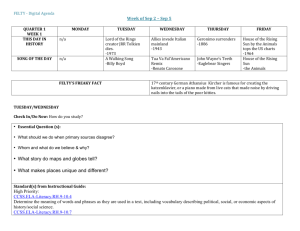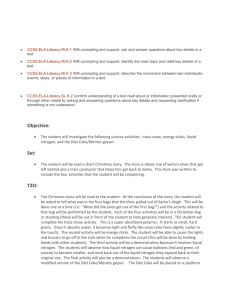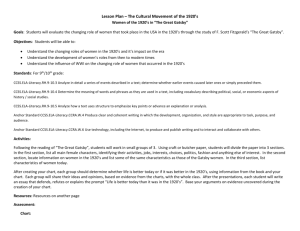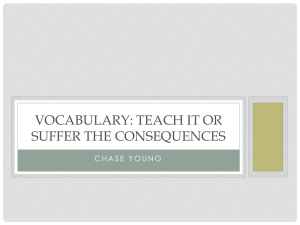File - Ouchi World History
advertisement
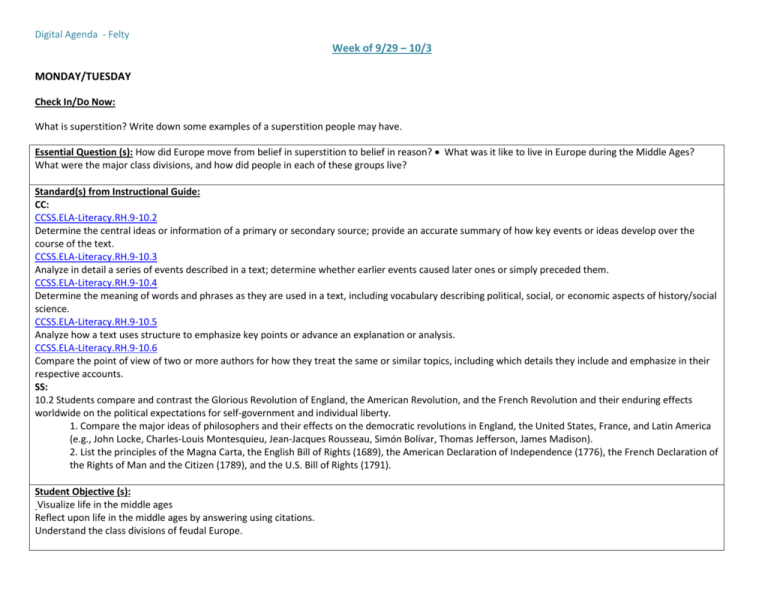
Digital Agenda - Felty Week of 9/29 – 10/3 MONDAY/TUESDAY Check In/Do Now: What is superstition? Write down some examples of a superstition people may have. Essential Question (s): How did Europe move from belief in superstition to belief in reason? What was it like to live in Europe during the Middle Ages? What were the major class divisions, and how did people in each of these groups live? Standard(s) from Instructional Guide: CC: CCSS.ELA-Literacy.RH.9-10.2 Determine the central ideas or information of a primary or secondary source; provide an accurate summary of how key events or ideas develop over the course of the text. CCSS.ELA-Literacy.RH.9-10.3 Analyze in detail a series of events described in a text; determine whether earlier events caused later ones or simply preceded them. CCSS.ELA-Literacy.RH.9-10.4 Determine the meaning of words and phrases as they are used in a text, including vocabulary describing political, social, or economic aspects of history/social science. CCSS.ELA-Literacy.RH.9-10.5 Analyze how a text uses structure to emphasize key points or advance an explanation or analysis. CCSS.ELA-Literacy.RH.9-10.6 Compare the point of view of two or more authors for how they treat the same or similar topics, including which details they include and emphasize in their respective accounts. SS: 10.2 Students compare and contrast the Glorious Revolution of England, the American Revolution, and the French Revolution and their enduring effects worldwide on the political expectations for self-government and individual liberty. 1. Compare the major ideas of philosophers and their effects on the democratic revolutions in England, the United States, France, and Latin America (e.g., John Locke, Charles-Louis Montesquieu, Jean-Jacques Rousseau, Simón Bolívar, Thomas Jefferson, James Madison). 2. List the principles of the Magna Carta, the English Bill of Rights (1689), the American Declaration of Independence (1776), the French Declaration of the Rights of Man and the Citizen (1789), and the U.S. Bill of Rights (1791). Student Objective (s): Visualize life in the middle ages Reflect upon life in the middle ages by answering using citations. Understand the class divisions of feudal Europe. Assessment and Student Reflection: Students complete a Unit Pre-Assessment Reflect on each of their stations and work done. WHOLE GROUP 1. Do Now 2. Unit Pre-Assessment – Complete Pre-Assessment on Google Forms to best of your ability 3. BLAST a. Direct: The Dark Ages in Film b. Collaborative: Create an Infographic – the Feudal System DIRECT STATION Expected Output: For each clip, look for and write down: Superstition Logic Inequality Watch clips: Monty Python and the Holy Grail: She’s a Witch! History’s Vikings: First Meeting with Floki the Boatbuilder A Knights Tale: Chaucer Introducing Sir Ulrich Pillars of the Earth: Price of Wool Answer: What was it like to live in Europe during the Middle Ages? Use an example from each clip watched. WEDNESDAY Check In/Do Now: COLLABORATIVE STATION Expected Output: Create an infographic about feudalism Reader: Responsible for reading and researching what the feudal system is and who is in each level. Translator: Responsible for creating the written portions of the infographic based on the information that the reader finds. Must work with reader to determine information needed and with artist to determine what art goes with the written portions of the infographic. Dictionary: looks up and writes down any and all words with definitions that the group did not know. Works with reader and translator to find words and look up. All words looked up must be included on the infographic. Artist: Creates all art and arranges the infographic. Works with all other group members. Can be combined with Dictionary. INDEPENDENT STATION What do you know about HIV/AIDS? Essential Question (s): How does ignorance negatively effect society? Standard(s) from Instructional Guide: CC: CCSS.ELA-Literacy.RH.9-10.2 Determine the central ideas or information of a primary or secondary source; provide an accurate summary of how key events or ideas develop over the course of the text. CCSS.ELA-Literacy.RH.9-10.3 Analyze in detail a series of events described in a text; determine whether earlier events caused later ones or simply preceded them. CCSS.ELA-Literacy.RH.9-10.4 Determine the meaning of words and phrases as they are used in a text, including vocabulary describing political, social, or economic aspects of history/social science. CCSS.ELA-Literacy.RH.9-10.5 Analyze how a text uses structure to emphasize key points or advance an explanation or analysis. CCSS.ELA-Literacy.RH.9-10.6 Compare the point of view of two or more authors for how they treat the same or similar topics, including which details they include and emphasize in their respective accounts. Student Objective (s): Practice Historical Reading Strategies on primary sources Assessment and Student Reflection: Turn in Current Event at end of class period. WHOLE GROUP Clarify that what we are learning about is not about the dark ages: the people we are reading about are not inferior nor are they unintelligent. 1. Do Now 2. Current Events: AIDS Crisis 3. SOAPSTone, answered questions due at end of period. DIRECT STATION COLLABORATIVE STATION INDEPENDENT STATION THURSDAY/FRIDAY Check In/Do Now: Reflect upon how well you and your group are working. Rate each person from 1 to 5, five being the best rating, and explain why you gave that person that rating. (include yourself) Essential Question (s): How did Europe move from belief in superstition to belief in reason? Standard(s) from Instructional Guide: CC: CCSS.ELA-Literacy.RH.9-10.2 Determine the central ideas or information of a primary or secondary source; provide an accurate summary of how key events or ideas develop over the course of the text. CCSS.ELA-Literacy.RH.9-10.3 Analyze in detail a series of events described in a text; determine whether earlier events caused later ones or simply preceded them. CCSS.ELA-Literacy.RH.9-10.4 Determine the meaning of words and phrases as they are used in a text, including vocabulary describing political, social, or economic aspects of history/social science. CCSS.ELA-Literacy.RH.9-10.5 Analyze how a text uses structure to emphasize key points or advance an explanation or analysis. CCSS.ELA-Literacy.RH.9-10.6 Compare the point of view of two or more authors for how they treat the same or similar topics, including which details they include and emphasize in their respective accounts. SS: 10.2 Students compare and contrast the Glorious Revolution of England, the American Revolution, and the French Revolution and their enduring effects worldwide on the political expectations for self-government and individual liberty. 1. Compare the major ideas of philosophers and their effects on the democratic revolutions in England, the United States, France, and Latin America (e.g., John Locke, Charles-Louis Montesquieu, Jean-Jacques Rousseau, Simón Bolívar, Thomas Jefferson, James Madison). 2. List the principles of the Magna Carta, the English Bill of Rights (1689), the American Declaration of Independence (1776), the French Declaration of the Rights of Man and the Citizen (1789), and the U.S. Bill of Rights (1791). Student Objective (s): Visualize life in the middle ages Reflect upon life in the middle ages by answering using citations. Understand the class divisions of feudal Europe. Assessment and Student Reflection: Students complete a Vocabulary Quiz Reflect on each of their stations and work done. WHOLE GROUP 1. Do Now 2. Vocabulary Quiz 3. BLAST a. Collaborative: Feudal System Infographic b. Independent: Crash Course World History: Dark Ages DIRECT STATION COLLABORATIVE STATION Expected Output: Create an infographic about feudalism Reader: Responsible for reading and researching what the feudal system is and who is in each level. Translator: Responsible for creating the written portions of the infographic based on the information that the reader finds. Must work with reader to determine information needed and with artist to determine what art goes with the written portions of the infographic. Dictionary: looks up and writes down any and all words with definitions that the group did not know. Works with reader and translator to find words and look up. All words looked up must be included on the infographic. Artist: Creates all art and arranges the infographic. Works with all other group members. Can be combined with Dictionary. INDEPENDENT STATION Expected Output: Answer questions on Crash Course World History: Dark Ages in your notebook. Write a reflection when done.

